Researchers learn use of equipment for improved phenotyping
By Wandera Ojanji/CIMMYT
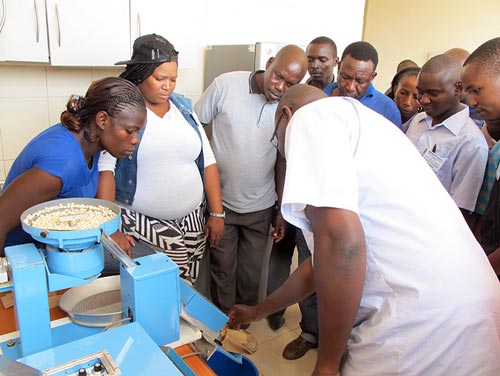
Amini Mataka, a research officer for CIMMYT’s Southern Africa Regional Office in Zimbabwe, was one of many Water Efficient Maize for Africa (WEMA) scientists and technicians who experienced difficulty using data generation and processing equipment.
But after attending the “Towards Quality Data through Effective and Efficient Use of Equipment in WEMA” training course held in Nairobi, Kenya, on 15-22 March, this is no longer the case. “I can now confidently and competently use the Motorola Scanner, make it compatible with computers and use Fieldbook to analyze data and prepare nurseries and trials,” Mataka said.
According to Stephen Mugo, CIMMYT Global Maize Program principal scientist and CIMMYT-WEMA team leader, these difficulties encouraged WEMA to train 28 scientists and technicians from CIMMYT and national agricultural research systems from the five WEMA countries – Kenya, Mozambique, South Africa, Tanzania and Uganda. The training provided participants with skills in the preparation of nurseries and trial design and seed preparation using Fieldbook; the printing of seed packet and field labels in Fieldbook; the basics of data collection using equipment and data analysis using appropriate software; and the use and care of computers, printers, seed counters, threshers and data collection equipment.
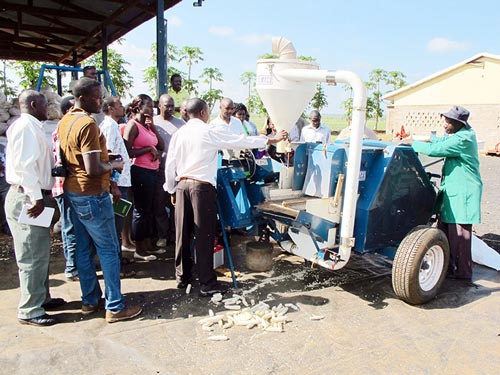
Caroline Thatelo, senior research technician for the Agricultural Research Council-South Africa, learned how to use Fieldbook, a tool developed by CIMMYT maize breeders for managing experiments and data analysis using the open-source data analysis software “R.” “We had problems using Fieldbook when we started,” Thatelo said. “But the practical demonstrations we have gone through have now made me perfect in the use of Fieldbook. I can now create an inventory, a seed increase nursery, a nursery to form single crosses, a stock list, consolidate inventories, generate trials and analyze data for single- and multi-location sites using Fieldbook.”
To some, like Gabriel Ambani, senior technician at the Kenya Agricultural Research Institute (KARI)-Kakamega, Kenya, the training was an eye-opener. “Before this training, I had no hands-on experience on the use of most of the equipment we were trained on, particularly the Motorola Scanner, label printers and bulk sheller,” he said. “I now have increased competence and am looking forward to applying my gained knowledge and skills to effectively use the equipment.”
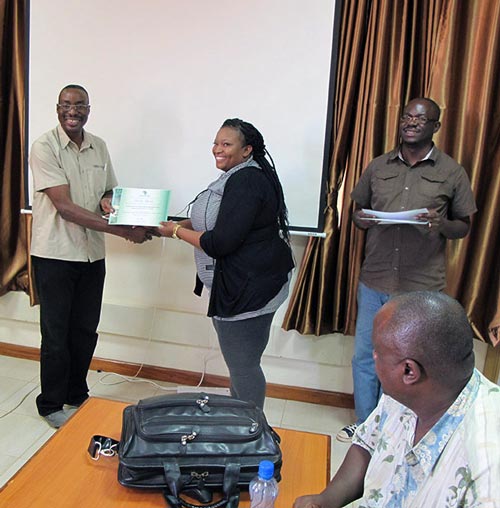
Sylvester Oikeh, WEMA project manager, called on the participants to put their new skills into use. “I want to see improvements in data collection and analysis. Do not be afraid to use the equipment and Fieldbook,” he said. “You are bound to make mistakes. But through the mistakes, you will figure out the right way to operate the equipment and use Fieldbook. You will get it right after several attempts.”
Several CIMMYT scientists and technicians helped organize and facilitate the workshop, including breeders Stephen Mugo and Yoseph Beyene; technicians Andrew Chavangi, John Gakunga and Collins Juma; and Joel Mbithi, CIMMYT-Kiboko farm manager. WEMA Phase II is funded by the Bill & Melinda Gates Foundation, the United States Agency for International Development-Feed the Future initiative and the Howard G. Buffett Foundation.
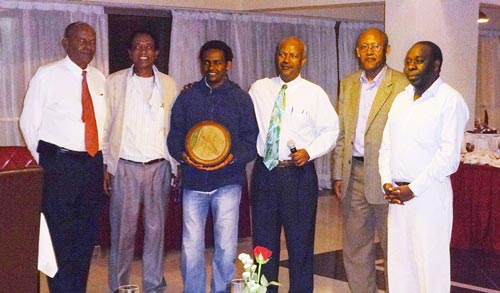
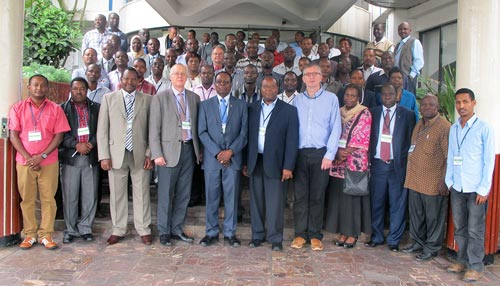
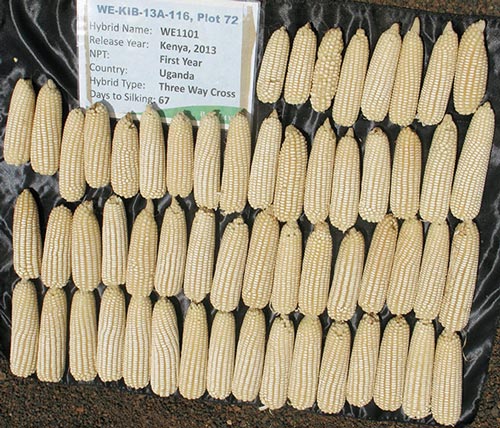
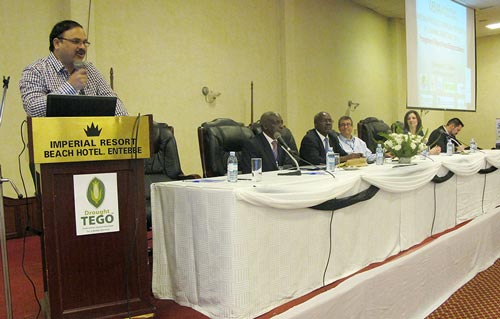
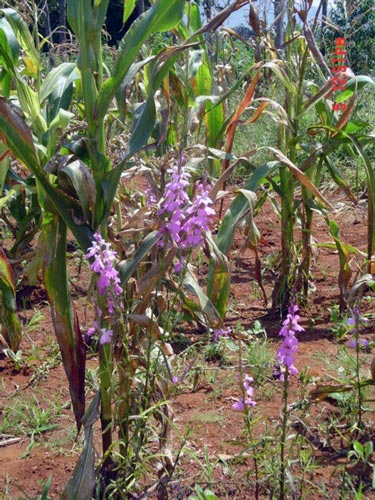
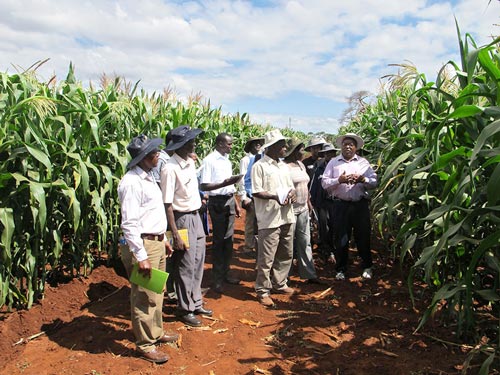 “The trip was an eye opener for me. We have no mass rearing facility in Ethiopia; neither do we practice artificial infestation of stem borers. We only undertake natural infestation for our trials, which does not give uniform infestation, leading us to wrong conclusions,” said Midekssa Ardessa from Bako Agricultural Research Center at the Ethiopian Institute of Agricultural Research (EIAR), who visited CIMMYT-Kenya during 21-27 July 2013 with a team of scientists from Ethiopia, Uganda, Tanzania, and Mozambique, to gain hands-on experience in breeding insect-resistant maize. “We are now very knowledgeable on mass rearing of stem borers and on running an insectary after our visit and practical sessions at the CIMMYT Katumani Insectary,” added Abiy Dibaba from EIAR’s Melkasa Agricultural Research Center. “At the CIMMYT Kiboko Postharvest Lab, we learned a lot about maize weevils and the larger grain borer, and how to screen maize for resistance against these postharvest pests.”
“The trip was an eye opener for me. We have no mass rearing facility in Ethiopia; neither do we practice artificial infestation of stem borers. We only undertake natural infestation for our trials, which does not give uniform infestation, leading us to wrong conclusions,” said Midekssa Ardessa from Bako Agricultural Research Center at the Ethiopian Institute of Agricultural Research (EIAR), who visited CIMMYT-Kenya during 21-27 July 2013 with a team of scientists from Ethiopia, Uganda, Tanzania, and Mozambique, to gain hands-on experience in breeding insect-resistant maize. “We are now very knowledgeable on mass rearing of stem borers and on running an insectary after our visit and practical sessions at the CIMMYT Katumani Insectary,” added Abiy Dibaba from EIAR’s Melkasa Agricultural Research Center. “At the CIMMYT Kiboko Postharvest Lab, we learned a lot about maize weevils and the larger grain borer, and how to screen maize for resistance against these postharvest pests.”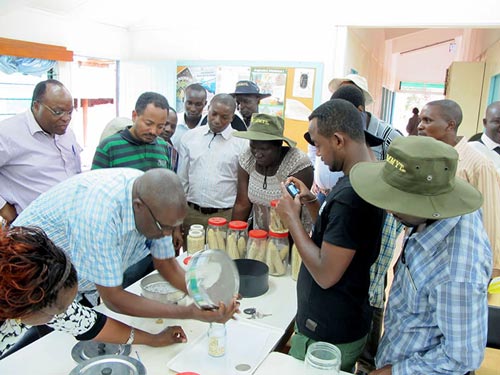 The annual IRMA project’s program has trained more than 50 scientists since its inception in 2009. “Most of us talk very easily and confidently about insect rearing. However, it is quite a challenge when we engage in the practical aspects,” said Tefera. “What we have exposed you to is just a tip of the iceberg in the business of mass rearing of insects. There is still a lot to learn, much of it by yourself as you engage in the practical aspects of it.” The participants appreciated the effort taken by the organizers. One of them, Egas Nhamucho of IIAM, said: “Infestation of maize with stem borers was a real learning point for me, a real delicate task of picking out very tiny 10 insect larvae, ensuring that you do not pierce and kill them with the camel brush, and carefully and strategically placing them on each maize plant. The practical sessions really made me appreciate some of the tasks we have always taken for granted.”
The annual IRMA project’s program has trained more than 50 scientists since its inception in 2009. “Most of us talk very easily and confidently about insect rearing. However, it is quite a challenge when we engage in the practical aspects,” said Tefera. “What we have exposed you to is just a tip of the iceberg in the business of mass rearing of insects. There is still a lot to learn, much of it by yourself as you engage in the practical aspects of it.” The participants appreciated the effort taken by the organizers. One of them, Egas Nhamucho of IIAM, said: “Infestation of maize with stem borers was a real learning point for me, a real delicate task of picking out very tiny 10 insect larvae, ensuring that you do not pierce and kill them with the camel brush, and carefully and strategically placing them on each maize plant. The practical sessions really made me appreciate some of the tasks we have always taken for granted.”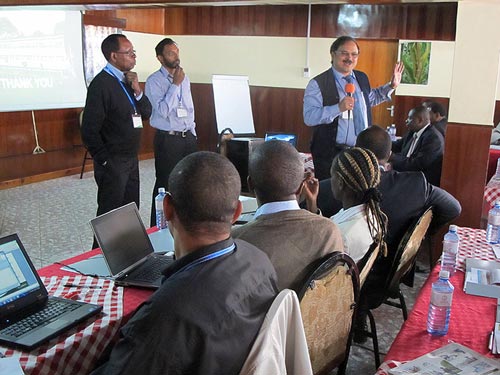 “I can now identify with accuracy plants affected with maize lethal necrotic disease,” stated Regina Tende, PhD student attached to CIMMYT, after attending the CIMMYT-Kenya Agricultural Research Institute (
“I can now identify with accuracy plants affected with maize lethal necrotic disease,” stated Regina Tende, PhD student attached to CIMMYT, after attending the CIMMYT-Kenya Agricultural Research Institute (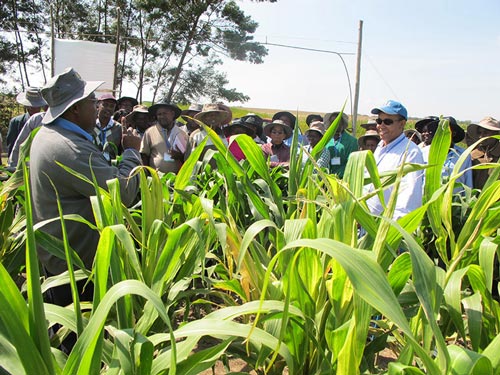 During his opening speech, Joseph Ng’etich, deputy director of Crop Protection, Ministry of Agriculture, noted that about 26,000 hectares of maize in Kenya were affected in 2012, resulting in an estimated loss of 56,730 tons, valued at approximately US$ 23.5 million. Seed producers also lost significant acreages of pre-basic seed in 2012: Agriseed lost 10 acres in Narok; Kenya Seed lost 75; and Monsanto 20 at Migtyo farm in Baringo, according to Dickson Ligeyo, KARI senior research officer and head of Maize Working Group in Kenya.
During his opening speech, Joseph Ng’etich, deputy director of Crop Protection, Ministry of Agriculture, noted that about 26,000 hectares of maize in Kenya were affected in 2012, resulting in an estimated loss of 56,730 tons, valued at approximately US$ 23.5 million. Seed producers also lost significant acreages of pre-basic seed in 2012: Agriseed lost 10 acres in Narok; Kenya Seed lost 75; and Monsanto 20 at Migtyo farm in Baringo, according to Dickson Ligeyo, KARI senior research officer and head of Maize Working Group in Kenya.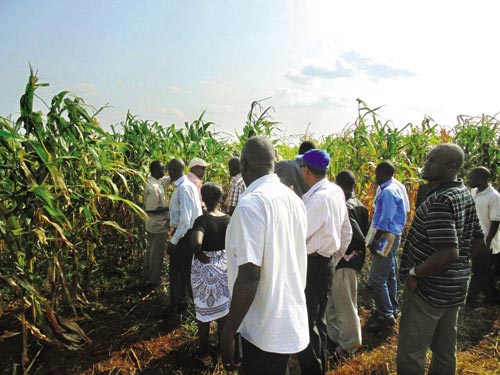
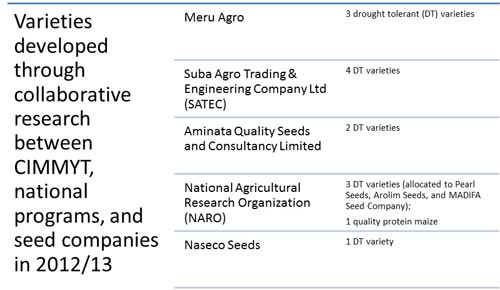
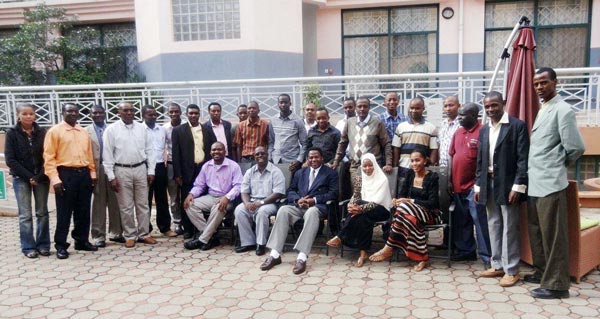
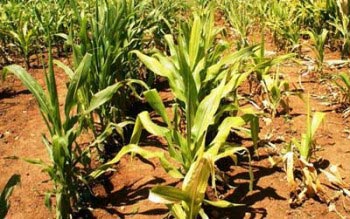 The maize lethal necrosis (MLN) disease first appeared in Kenya’s Rift Valley in 2011 and quickly spread to other parts of Kenya, as well as to Uganda and Tanzania. Caused by a synergistic interplay of maize chlorotic mottle virus (MCMV) and any of the cereal viruses in the family, Potyviridae, such as Sugarcane mosaic virus (SCMV), Maize dwarf mosaic virus (MDMV), or Wheat streak mosaic virus (WSMV), MLN can cause total crop loss if not controlled effectively.
The maize lethal necrosis (MLN) disease first appeared in Kenya’s Rift Valley in 2011 and quickly spread to other parts of Kenya, as well as to Uganda and Tanzania. Caused by a synergistic interplay of maize chlorotic mottle virus (MCMV) and any of the cereal viruses in the family, Potyviridae, such as Sugarcane mosaic virus (SCMV), Maize dwarf mosaic virus (MDMV), or Wheat streak mosaic virus (WSMV), MLN can cause total crop loss if not controlled effectively.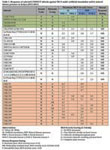
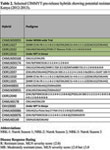
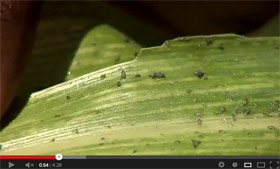
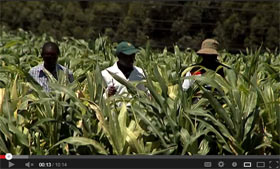
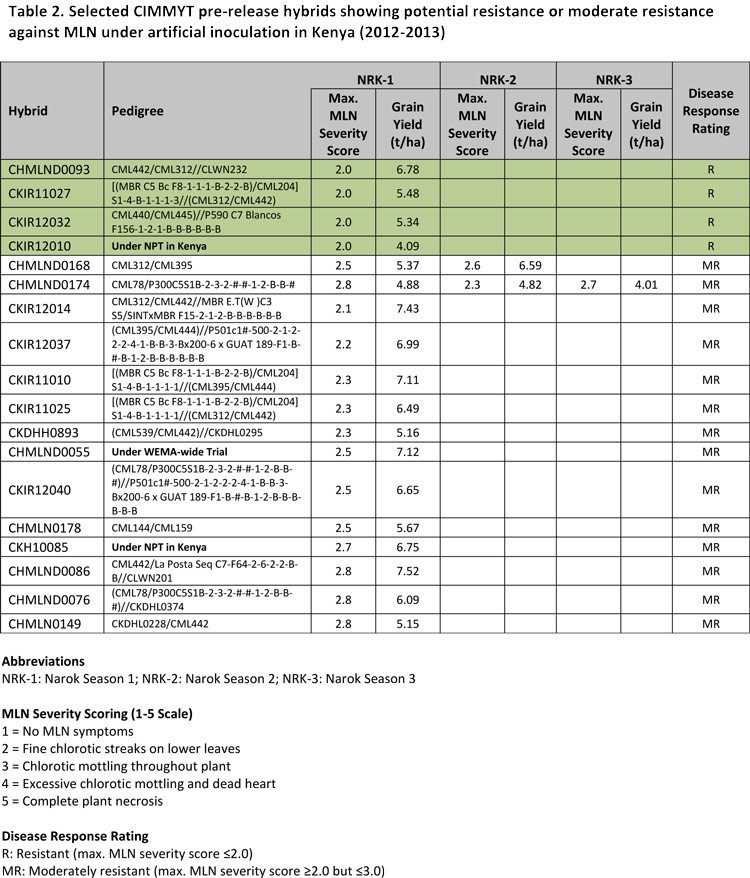 Download table in pdf format
Download table in pdf format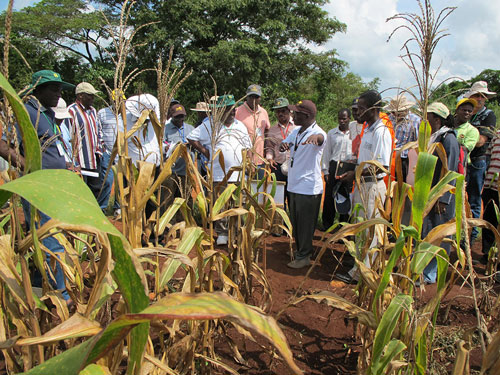 Over 200 researchers, policy makers, donors, seed companies, and NGO representatives from Africa and Australia gathered in Chimoio, Mozambique, during 17-23 March 2013 for the third
Over 200 researchers, policy makers, donors, seed companies, and NGO representatives from Africa and Australia gathered in Chimoio, Mozambique, during 17-23 March 2013 for the third  A recently-emerged disease in Eastern Africa, maize lethal necrosis (
A recently-emerged disease in Eastern Africa, maize lethal necrosis (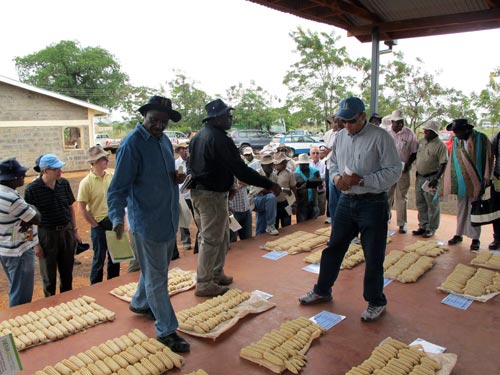 During 4-8 February 2013, stakeholders of the Water Efficient Maize for Africa (
During 4-8 February 2013, stakeholders of the Water Efficient Maize for Africa (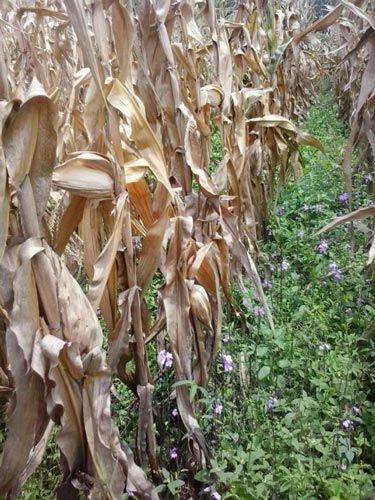
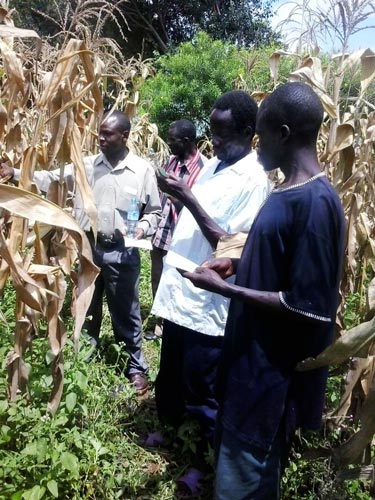 The field day was attended by James Ogwang, director of National Crops Resources Research Institute (NaCRRI) at Namulonge; Godfrey Asea, maize breeder and head of the Cereals Program; Pearl and NASECO seed companies representatives; Sammy Waruingi from BASF; and CIMMYT maize breeder Dan Makumbi and research assistant Edna Mageto. Ogwang urged the farmers to plant only certified seed and move beyond border issues to work together in Striga management. Asea thanked the government and farmers for their support in the fight against Striga. He said the farmers had become good project ambassadors.
The field day was attended by James Ogwang, director of National Crops Resources Research Institute (NaCRRI) at Namulonge; Godfrey Asea, maize breeder and head of the Cereals Program; Pearl and NASECO seed companies representatives; Sammy Waruingi from BASF; and CIMMYT maize breeder Dan Makumbi and research assistant Edna Mageto. Ogwang urged the farmers to plant only certified seed and move beyond border issues to work together in Striga management. Asea thanked the government and farmers for their support in the fight against Striga. He said the farmers had become good project ambassadors.